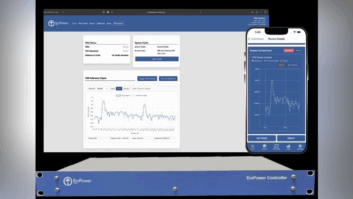Radio frequency (RF) radiation, RF emissions, electromagnetic energy – whatever you choose to call it, the FCC regulations and an increased awareness of RF radiation are hot topics today.
Although the FCC adopted new regulations in 1997 and all companies were supposed to be fully compliant by September 2000, many organizations still have a long way to go. With the FCC poised to issue its first-ever fines for RF safety violations, many companies are giving more thought to what they should be doing to improve safety. (Ed. Note: Subsequent to publication of this article, the FCC indeed announced such a fine, against a radio station in New Mexico.) The reasons for doing so should be obvious: protection of personnel, compliance with regulations and reducing liability.
Hazard control equipment has been an essential tool of industrial hygiene and safety professionals in many areas for decades. But RF radiation (RFR) hazard control equipment has only been available for the broadcast industry for about 10 years. And, judging by the industry buzz, there is a lot of confusion about its application and use.
There are basically two types of RFR hazard control equipment available: RF personal monitors and protective garments. What are the important things to consider when selecting and using an RF personal monitor? What level of protection do RF “suits” provide? Can personal monitors be used with protective garments? These are important questions. Anyone who uses or is considering the use of RF PPE should know the answers.
RF personal monitors
Personal monitors are designed to sound an alarm above a preset threshold.There are several factors that should be considered in selecting a monitor:
Frequency range: The first monitors developed for the military covered the microwave band only. The latest designs are very broadband. One design operates from 100 kHz to 100 GHz. A monitor should cover all the emitters where you are going to work.
Frequency response: Monitors can have a “flat” frequency response or a “shaped” response. A sensitivity of a shaped sensor varies with frequency.
For example, the FCC’s Maximum Permissible Exposure (MPE) limit for Occupational/Controlled exposure at VHF frequencies (30-300 MHz) is 1 mW/cm². Below 3 MHz it is 100 mW/cm².
Take a simple site with one AM and one FM antenna, and you can see the advantage of a shaped sensor that responds in terms of “Percent of Standard.” With a flat response, if the total field level from the two antennas is greater than 1 mW/cm², you cannot determine whether you are exposed above the MPE. If you are exposed to a 20 mW/cm² field, with 19.9 mW/cm² coming from the AM and 0.1 mW/cm² from the FM, you are only at about 30 percent of the MPE (19.9/100 + 0.1/1).
Of course, if half the field were coming from each antenna, then you would be at 1,010 percent of the MPE (10/100 + 10/1). Monitors are typically set to trigger at 50 percent of the MPE to allow for measurement uncertainty. Note that an average, ungrounded adult male makes a great Channel 6 or FM antenna, depending on his height.
Fields Detected: Monitors detect the E-field, the H-field, or both. At the lower frequencies, induced and contact currents are more of a threat than thermal affects. Both are related to the strength of the electric field.
That is why the most modern standards, such as IEEE C95.1-1999, allow much higher magnetic fields below 100 MHz. At AM frequencies, even a “heavy” magnetic field is never more than 10 dB higher than the electric field. Yet the IEEE limit is 10,000 times higher for the magnetic field at these frequencies. Yes, FCC MPE limits are the same for both fields, but the IEEE standard is biologically more correct. At 50 MHz to 100 MHz you might be in the near field 5-10 feet from the antenna.
So, unless you are essentially on top of one of these high-power broadcast antennas, an accurate E-field sensor works very well. But be careful, dipole electric field detectors do not work on the body below 50 MHz.
Once you have your RF personal monitor, there are a few things to consider:
Where to wear the monitor: Monitors are directional and should be worn on the torso facing forward. Your eyes and testes are the most vulnerable parts of your anatomy. It is not possible to make an RF personal monitor that works isotropically on the body.
Although the monitors do not detect what is behind you, they are generally very effective, providing you do not stay motionless. The problem is heating, so as long as you move occasionally, the monitor should pick up the field.
Where not to wear the monitor: Wearing monitors on your belt over the back pocket brings new meaning to the concept of CYA, but it is not the correct place to wear a monitor. And RF personal monitors do not work underneath RF protective garments. Wearing a RF personal monitor under a RF protective suit appears to make sense to those that are not familiar with the personal monitors and the suits. It would seem that the monitor would simply detect what is getting through to the wearer.
This approach – wearing the monitor under the protective suit – does not work, is potentially unsafe for the wearer and would never be recommended by the manufacturer of the personal monitor.
RF protective garments
Personal monitors can tell you where you cannot go or should not remain, but what if you need to work in an area with significant RF fields?
Protective garments are often a good solution to this problem. These suits can be considered Personal Protective Equipment (PPE). As with personal monitors, there is often confusion about protective garments. These garments provide a substantial amount of protection, 10 dB minimum and often more, and work above 50 MHz.But there are limitations and cautions, especially at lower frequencies, such as in the AM radio band:
Protection is limited: Putting on an RF protective garment should not be equated with Clark Kent changing into his Superman outfit in a phone booth.
The manufacturers of these garments stress that you should know the intensity of the field that you are entering. Yet, most survey instruments are not usable at these high field levels, which leaves computer modeling as the most common method. The conservative, recommended approach is to assume 10 dB of protection – restrict your work to areas that are no higher than 1,000 percent of the MPE limits.
Suits must be worn properly: Suits should never be used without the hood above 800-900 MHz due to the potential for eye and brain damage at those frequencies. Hoods are generally not required below 400-500 MHz. At frequencies in between, the suits can be used at levels of 300-500 percent of the MPE.
It is critical that the body of the suit makes intimate contact with the special conductive socks. The importance of making good contact between the main part of the suit and the conductive socks cannot be overemphasized, especially if you intend to work at lower frequencies, such as near an AM radio station.
The suits need to have a path to ground to work properly. If you leave the socks off, you not only do not have a good path to ground, but the currents into the suit pass through your ankles. The current density in the ankles can be very high due and can produce very high Specific Absorption Rates. If your ankles feel warm, something is wrong.
Other considerations: The coverall, gloves, socks and hood can impede mobility and add to heat stress, and the hood can limit visibility.
A new high-power RF personal monitor is now available for use on the outside of RF protective garments. This combination of suit and monitor is the ideal solution to working in high-level RF fields. Just remember, if the monitor sounds an alarm at 1,000 percent, it is time to back off and get the power reduced before you proceed.







